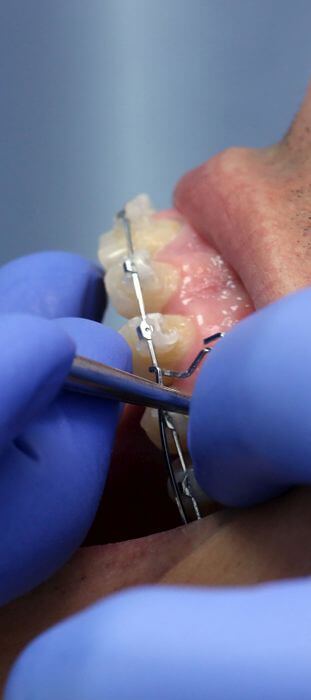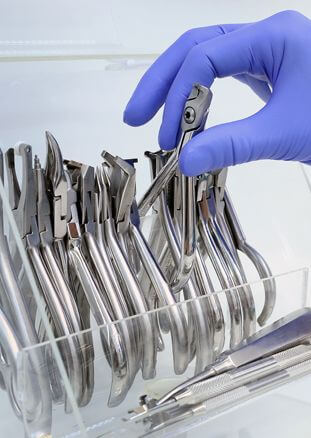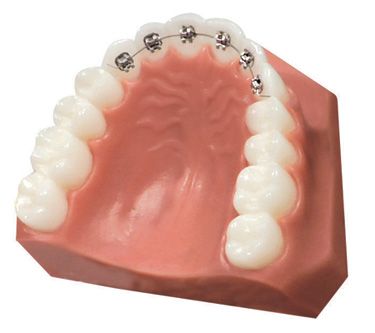Reception: ![]() +36/30 show
+36/30 show
6721 Szeged, Osztrovszky utca 12.
Open every week-day since 1996
Open on week-days from 8 AM to 9 PM
24 578 satisfied customers
Serving you since 1996
We would like to help you better understand the different types of orthodontic appliances that are available. In our dental clinic, we aim at ensuring that our clients, whatever their age, can receive the orthodontic treatment that is ideal for them. If you are a parent, you can make sure early on that the teeth of your child develop beautifully and in a normal way. If you are an adult, now you have the chance to receive the orthodontic treatment that you may have missed out on as a child.
Not everyone has the luck to have perfectly regular teeth. Teeth irregularities may be caused by a variety of factors, some of which may be genetic. Orthodontic treat-ments serve to correct these teeth irregularities.
Occasionally, teeth crowding or irregularity may be caused by physical effects. Dur-ing growth, the human body responds to the continuous use of the teeth by trying to even out the load affecting them, which may lead to irregular teeth alignment. As this typically occurs during childhood, parents should be especially aware of the fol-lowing:
Wisdom teeth that erupt irregularly or do not erupt at all may also be responsible for teeth crowding. The wisdom tooth exerts continuous pressure on the neighbouring teeth. This limits the space available for the teeth in the oral cavity, which gradually causes teeth crowding.
Less frequently, otorhinolaryngological problems may also cause teeth to develop ir-regularly. In such conditions, your child should be seen not only by an otolaryngolo-gist but also by a specialist orthodontist as this ensures the best solution.
Parents play a crucial role in recognising malformations. If you see a specialist orthodontist early on, you can prevent the development of severe irregularities that may be much more difficult to correct in adulthood.
vissza a kérdésekhez
Most patients contact specialist orthodontists because of aesthetic concerns and corrections. Few people are aware of the health problems that irregular teeth may cause even as far as our healthy teeth are concerned. When left uncorrected, irregular teeth and the uneven load they involve may lead to the development of temporomandibular joint disorders.
Orthodontic treatment therefore offers safe, non-intrusive, and long-term solutions to the following problems:
Orthodontic appliances such as braces can help realign the teeth within a period of one to two years, improving both the aesthetics and the functionality of the teeth. During the reten-tion period, various types of orthodontic appliances called retainers help hold your teeth in their new positions. The solution that is most suitable for you will depend partly on the na-ture of the dental problem you have and partly on your personal preferences and possibilities.
vissza a kérdésekhez
Fitting the orthodontic appliance is completely pain-free. Once the surfaces of the affected teeth are cleaned, so-called brackets are attached to them using dental cement. These may vary depending on the type of the appliance used. The procedure takes about half an hour. No anaesthetic is required because the procedure is pain-free.
Once the braces are fitted, they start correcting the position of your teeth. At this stage, you may feel a certain pulling tension that may be somewhat unpleasant for a while. You have to get used to this pulling tension and to eating with your braces fitted. It is a good idea to avoid eating chewy food. The overwhelming majority of patients only experience this sensa-tion for a period of two to three days each time after their braces are adjusted.
At the end of the orthodontic realignment process, your braces will be removed from your teeth easily, quickly, and without any trace.
vissza a kérdésekhez
Once you get used to your braces, they will not have any effect of your speech. Certain sensitive patients may experience subtle changes in their speech that may last for a day or two after the braces are fitted; however, this is rare, and these subtle changes disappear completely.
vissza a kérdésekhezAdults who, as children, did not have a chance to have their teeth realigned may nonetheless want to have a beautiful set of teeth, or, in fact, may need orthodontic treatment because of dental problems.
Over the past decade, there has been astonishing progress in the dental sciences. New or-thodontic techniques and solutions have been developed specifically for the treatment of adults. Invisible braces have become available for those who were previously put off by visi-ble braces. Now, athletes, actors and actresses, politicians, musicians, singers, artists, media personalities, and others in high-visibility roles can also undergo orthodontic treatment thanks to these novel technologies.
We at Dentha Dentistry Szeged pay special attention to making sure that you fully under-stand the treatment and its financial implications without any surprises. During the personal consultation, our specialist orthodontist will examine you. Based on the finding, you and our specialist orthodontist will work together to identify the best orthodontic treatment option. Taking the time to have this consultation is time well invested because orthodontic treat-ment is a life-time solution where the right decision can only be taken when all the neces-sary information is available.
vissza a kérdésekhez
On average, orthodontic treatment takes one and a half years. The exact time span will depend on four factors:
This period of orthodontic treatment is followed by what we call the retention period, which normally takes one year. The objective of this is to make sure that the realigned teeth retain their new positions. While one year may sound like a long period of time, patients testify that it is easy to get used to wearing the retainers at night and that months fly by fast, while the great results of orthodontic treatment stay with you for the rest of your life.
vissza a kérdésekhez
vissza a kérdésekhez

During the second consultation session, we walk you through the finished plans. Based on this briefing, you and your specialist orthodontist decide which option is best for you. This final decision will be recorded in the treatment plan.
Once you have decided to have your teeth aligned, we will make sure that your teeth are hygienically impeccable and then proceed to fit your braces, which will be the be-ginning of the treatment process. Fitting the braces is pain-free. Depending on the type of the appliance, your dentist will check and adjust your braces once a month. The date and time of the first adjustment visit will be agreed already at the time the braces are fitted.
vissza a kérdésekhez
At Dentha Dentistry Szeged, our aim is to ensure that while we perform our work based on the highest professional criteria, we also meet your personal needs and expectations throughout the orthodontic treatment:
vissza a kérdésekhez

Orthodontic appliances fall into one of three main categories as far as their technology is concerned:
Removable braces
Removable braces should be worn 14 hours a day – that is, in the afternoon, in the evening, and at night. They need to be controlled regularly. These braces come in a wide range of colours to make them more easily acceptable for children, their primary users.
Fixed braces
Fixed braces are attached to the teeth, with intelligent springy wires controlling the move-ment of the teeth. In addition to traditional metal braces, other options are also available, including porcelain braces for better aesthetic appeal and even invisible braces cemented into position lingually.
Micro implants
Braces may be attached to micro implants, fixed elements helping the teeth move. Micro implants are used in combination with fixed braces. When the orthodontic treatment only affects part of the dentition, micro implants are also used as stand-alone orthodontic appli-ances (e. g. in the site of a missing tooth or to push back a lifted tooth). Once the desired result has been achieved, the micro implants are removed.
Fixed orthodontic appliances
These appliances are attached to the teeth using brackets; thus, they remain in position throughout the entire duration of the orthodontic treatment. They consist of brackets, O-rings or tubes, and archwires. The brackets may be made of metal, porcelain, or a combination of these two materials.
Self-ligating orthodontic appliances
Traditional braces use brackets and elastic rubber bands. These hold the archwire firmly on the brackets. This is what we call ligating. Over time, these rubber bands may lose their elasticity and therefore need to be replaced every time you pay an adjustment visit to the dental clinic. They may also discolour if they come in contact with certain foods.
However, in the case of self-ligating orthodontic appliances, there is no need for the elastic rubber bands. The locking mechanism built into the brackets hold the archwires in position. They move teeth into their ideal position with less friction and more gently. This type of appliance is more elegant, easier to clean, and helps achieve the end result faster than traditional methods. Self-ligating braces also come in either metal or porcelain for a more aesthetically pleasing solution.
Please view this short video about German-made QuicKlear aesthetic porcelain self-ligating braces:
QuicKlear is a self-locking ceramic bracket you can wear comfortably and with a smile. These brackets allow you to achieve the desired result in shorter time. As they match your natural tooth shade, they give an outstanding aesthetic result that contributes to their popu-larity.
The third type is represented by self-ligating braces that are attached lingually and are therefore invisible. In-Ovation L®MTM brackets are a breakthrough in the field of invisible or-thodontic treatments. We recommend them to patients who place great emphasis on aes-thetic appeal but whose teeth are in need of only limited correction. Self-ligating brackets only take a few months to correct minor crowding in front teeth while they only need to be bonded to the six middle teeth in both the lower and upper jaws.

Invisible orthodontic appliances
In orthodontic treatment, Incognito, an invisible bracket system developed by 3M Unitek is clearly the top contender. This appliance is perfectly invisible to observers because it is bonded to the lingual, internal surface of your teeth. It is a stabile and durable solution for patients who eventually decide to have their teeth aligned as adults. Thanks to high-precision computer-aided design and manufacturing, every single element of this bracket system is fully custom-made to meet your personal needs. Like other systems, Incognito braces also take a bit of getting used to.
Please view this short video about 3M IMTEC Incognito, an invisible lingual bracket system:
The options listed above are only some of the wide range of solutions that are available to you if you decide to have beautiful and regular teeth. It is not easy to choose just the right solution out of so many options, but we are there to help you out. Please visit our dental clin-ic in downtown Szeged and get to know our specialist orthodontist, who will help you find the solution that is just ideal for you.
vissza a kérdésekhez